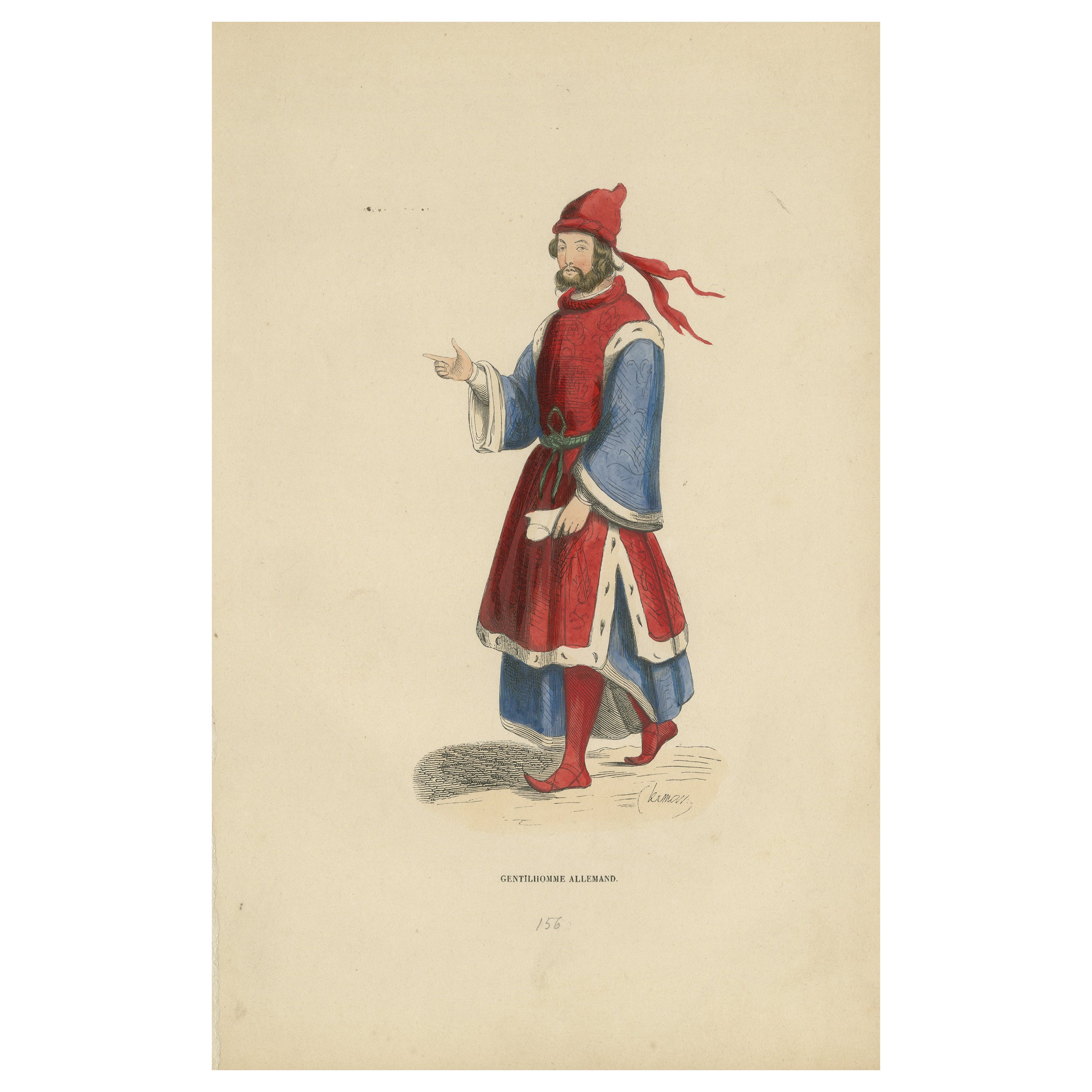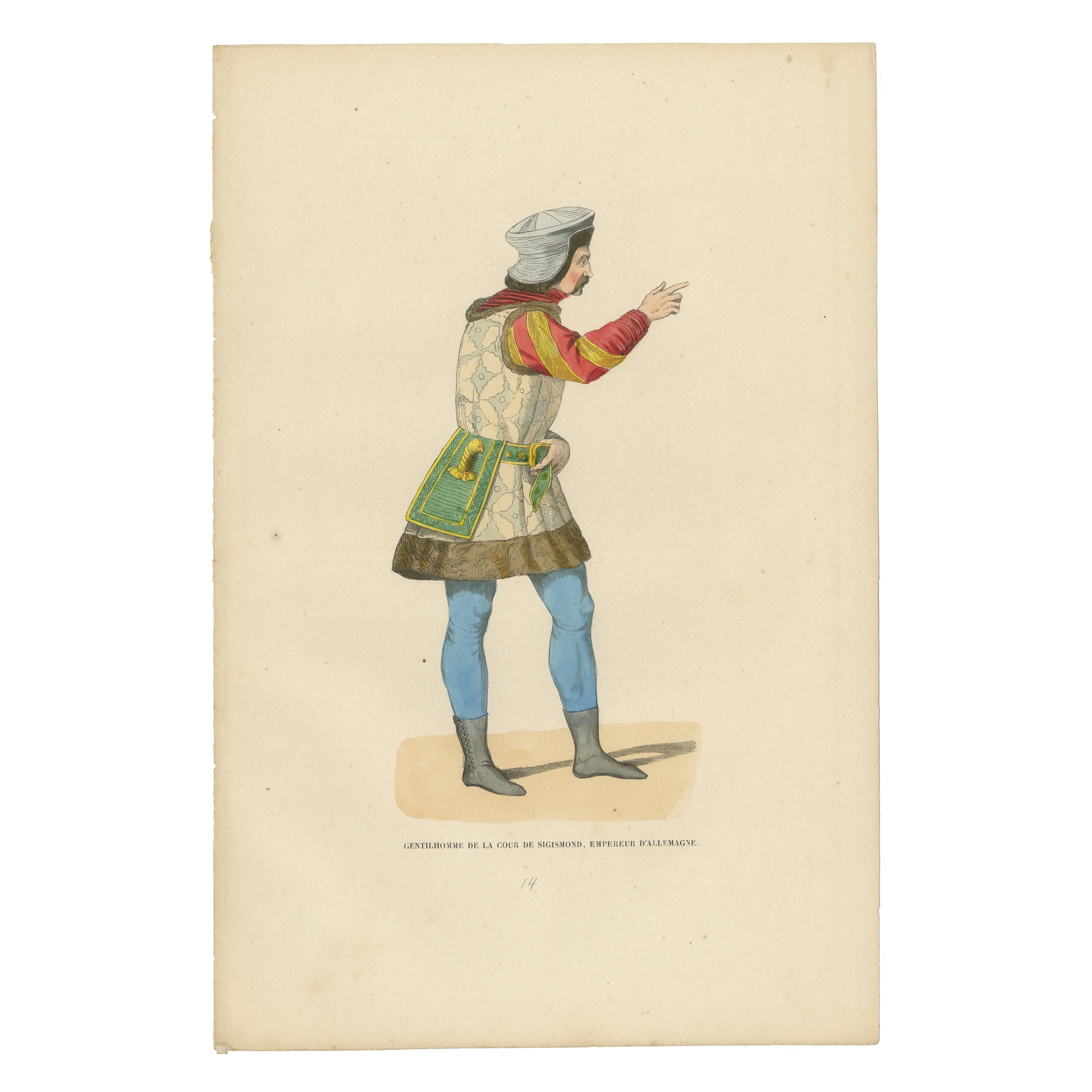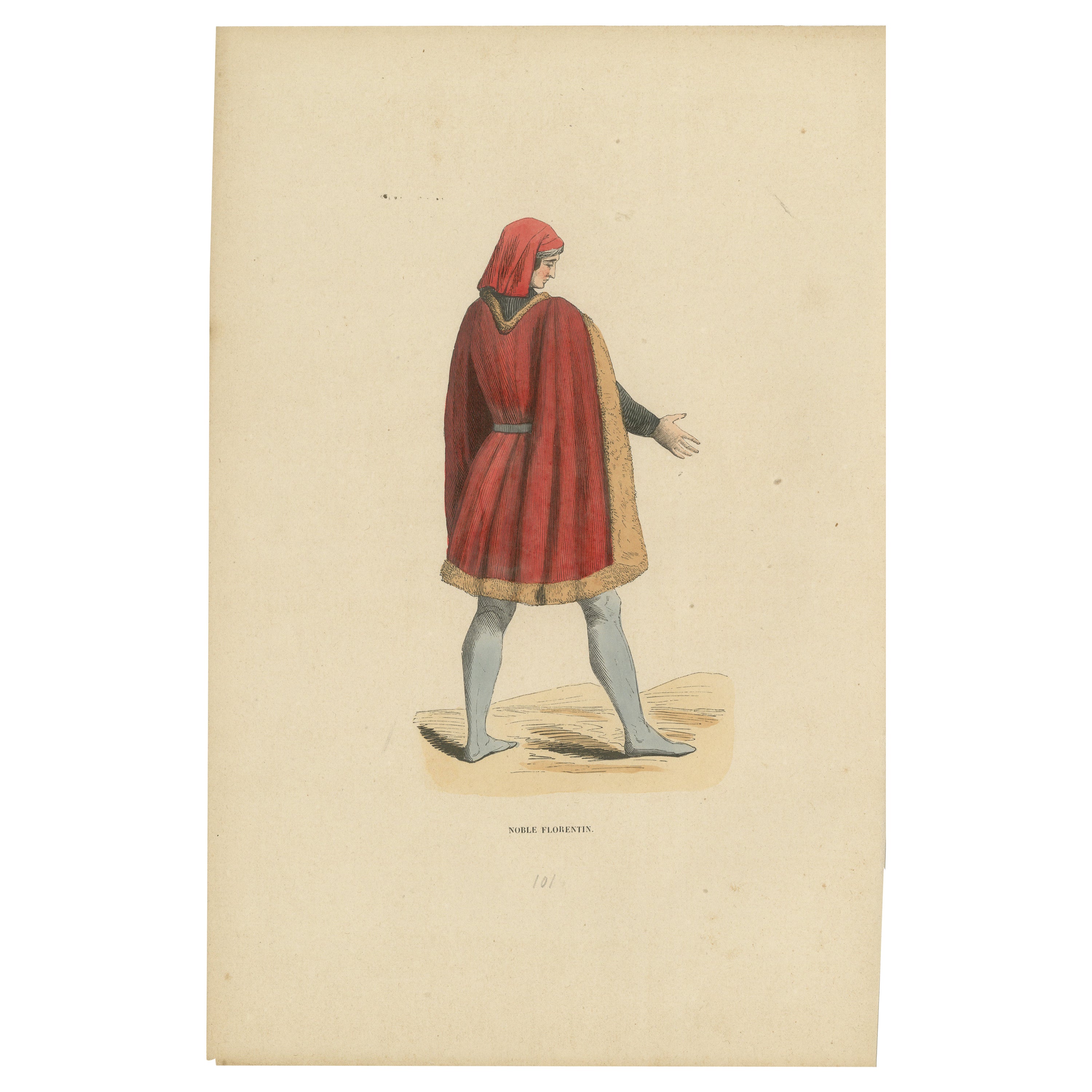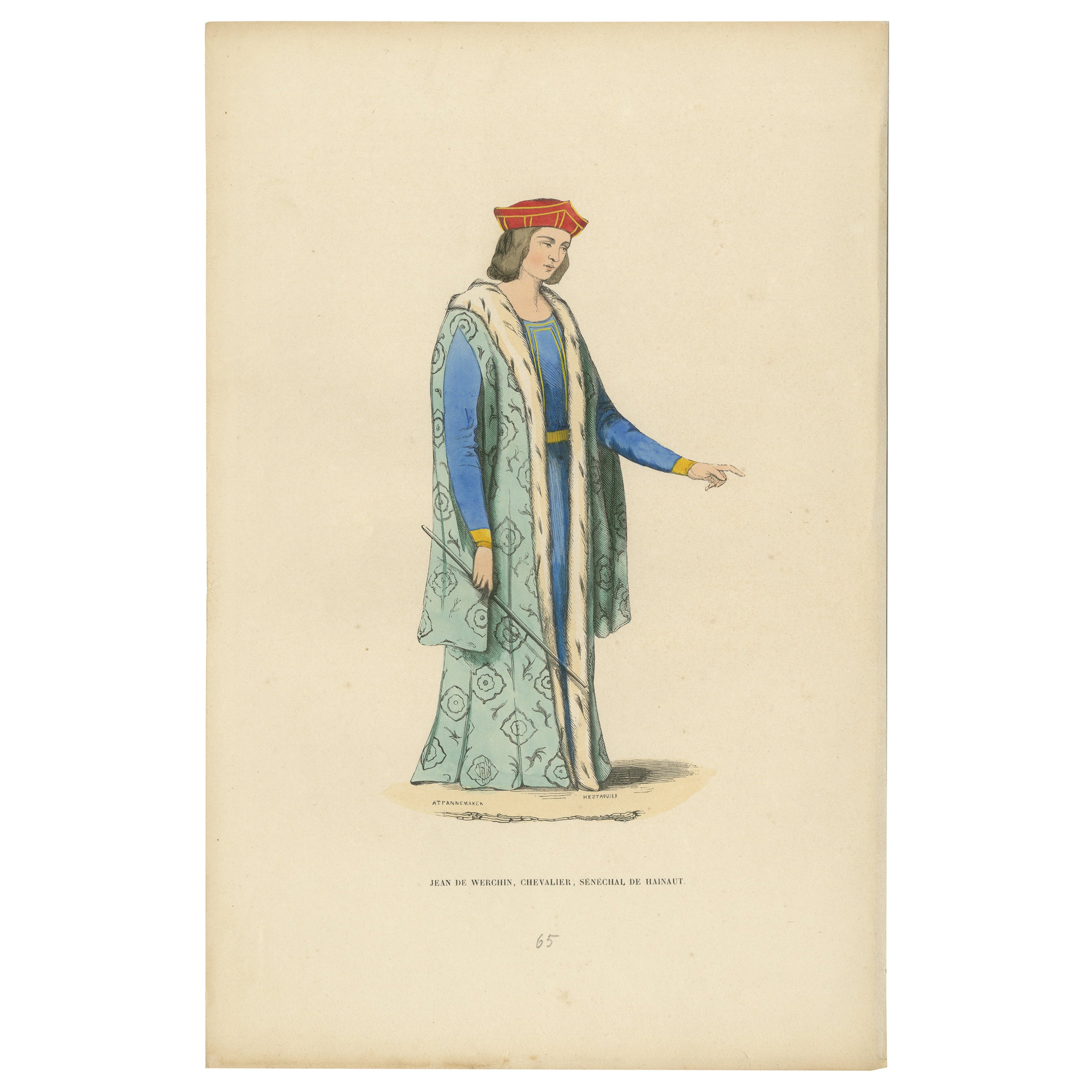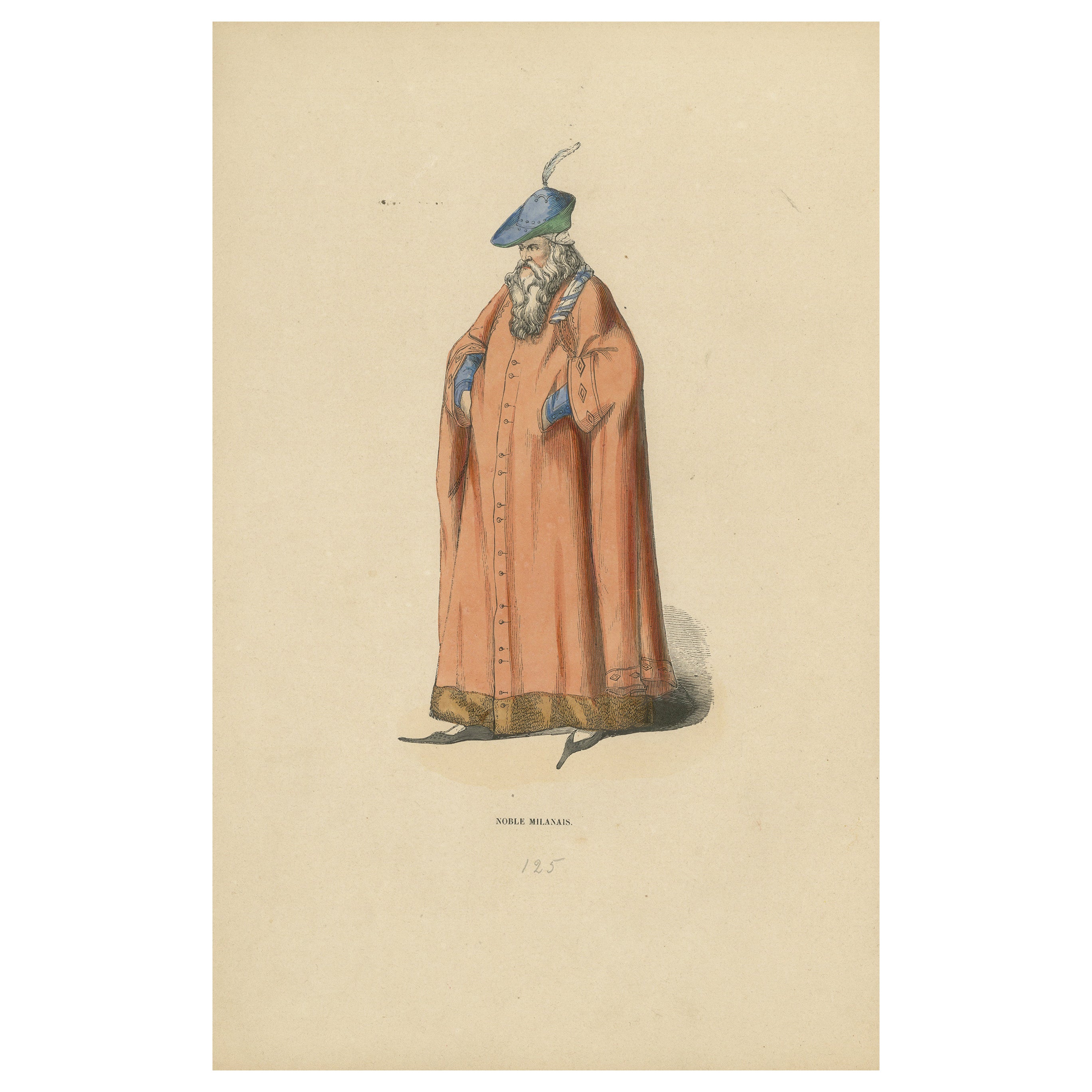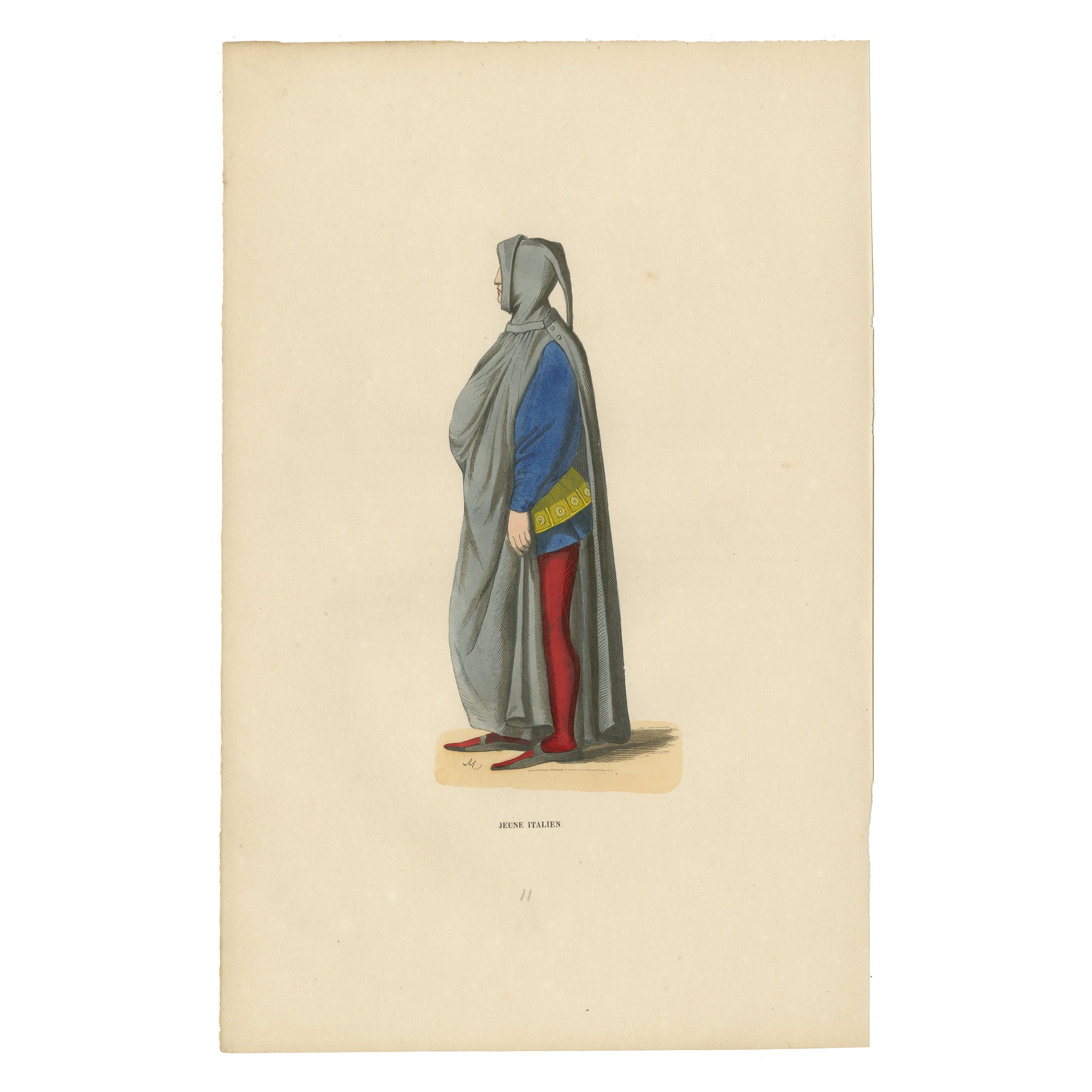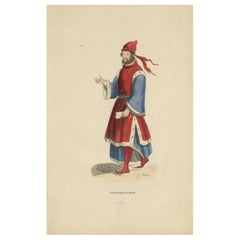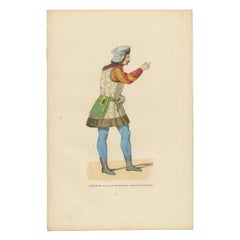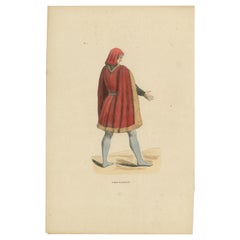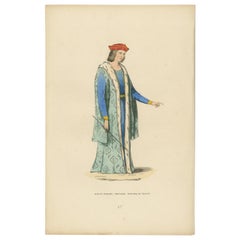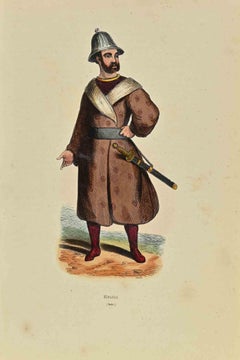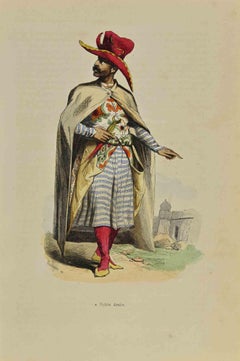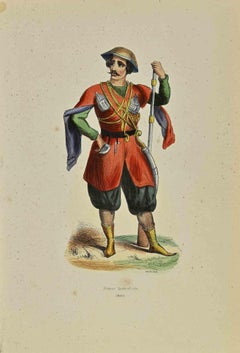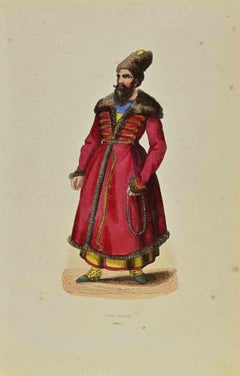Items Similar to German Nobleman of the Middle Ages: Elegance in Profile, 1847
Want more images or videos?
Request additional images or videos from the seller
1 of 7
German Nobleman of the Middle Ages: Elegance in Profile, 1847
$152.80
$19120% Off
£112.57
£140.7220% Off
€128
€16020% Off
CA$210.30
CA$262.8820% Off
A$233.36
A$291.7120% Off
CHF 123.09
CHF 153.8720% Off
MX$2,848.88
MX$3,561.1020% Off
NOK 1,557.38
NOK 1,946.7320% Off
SEK 1,458.61
SEK 1,823.2720% Off
DKK 974.34
DKK 1,217.9320% Off
About the Item
Title: "German Nobleman of the Middle Ages: Elegance in Profile"
Description: This vibrant print, original antique and hand-colored, presents a German nobleman from the Middle Ages, captured in a profile view that emphasizes his dignified posture and refined attire. He stands with one hand gesturing outward, perhaps in conversation or giving an instruction, indicative of his active role in the social and political spheres of the time.
The nobleman is adorned in a flowing, draped garment with a broad, decorative collar that encircles his neck, showcasing intricate patterns that reflect the era's attention to textile artistry. This piece of clothing is a testament to the wealth and status of the noble class, with its elaborate design and the apparent quality of the material.
His head is covered with a large, flat red hat with a distinctive green band, providing a bold contrast to his otherwise neutral-toned ensemble. Such a hat would not only serve as a fashion statement but also as a practical cover against the elements.
He carries a long, slender sword by his side, signifying his readiness to defend his honor or engage in the warfare that was a common part of noble life during those tumultuous times. The sword is also a symbol of his right to bear arms, a privilege reserved for the nobility.
The nobleman’s footwear is simple yet functional, with pointed toes that were fashionable during the period. The understated shoes suggest that while he is a person of importance, he is not ostentatious in displaying his wealth.
The simplicity of the background in the print directs the viewer's attention to the nobleman's figure, with the focus on his clothing, accessories, and the subtle details that convey his aristocratic standing. Through this portrayal, the print invites contemplation of the cultural and societal norms that were conveyed through dress during the Middle Ages in Germany.
The colors have a nice glow over them. Historically, egg whites, known as glair, and sometimes egg yolk were indeed used in illumination and painting, particularly in manuscripts, to give colors a brighter appearance and to add a sheen or gloss to the work. This technique was quite common during the Middle Ages and into the Renaissance.
Egg whites can be applied as a varnish over pigments to enhance their brightness and to protect the colors. This application could make the colors appear more vivid and also add a slight glossy sheen to the surface of the image.
Egg yolk, on the other hand, was commonly used as a binding agent in paint. It forms the basis of tempera paint, a medium that was widely used before the advent of oil painting. Egg yolk helps to create a durable and long-lasting color that adheres well to various surfaces.
In the context of the print from 1847, it's less likely that egg whites or yolks were used directly on the print, as by that time, commercial printing processes would have been more advanced and less reliant on such manual methods. However, if this print is a representation of an earlier style or is meant to mimic the appearance of hand-painted manuscripts, the original artists might have employed techniques or materials that gave a similar effect to those achieved with egg-based binders and varnishes.
- Dimensions:Height: 10.63 in (27 cm)Width: 7.09 in (18 cm)Depth: 0 in (0.02 mm)
- Materials and Techniques:
- Period:
- Date of Manufacture:1847
- Condition:Good. Overal light toning and light soiling but the image itself clean and hand-colored almost 200 years ago and still in expliciet colors. Aged paper with typically warm, yellowish-brown hue, mostly around the edges. Study the images carefully.
- Seller Location:Langweer, NL
- Reference Number:Seller: BG-13635-681stDibs: LU3054337905722
About the Seller
5.0
Recognized Seller
These prestigious sellers are industry leaders and represent the highest echelon for item quality and design.
Platinum Seller
Premium sellers with a 4.7+ rating and 24-hour response times
Established in 2009
1stDibs seller since 2017
2,569 sales on 1stDibs
Typical response time: <1 hour
- ShippingRetrieving quote...Shipping from: Langweer, Netherlands
- Return Policy
Authenticity Guarantee
In the unlikely event there’s an issue with an item’s authenticity, contact us within 1 year for a full refund. DetailsMoney-Back Guarantee
If your item is not as described, is damaged in transit, or does not arrive, contact us within 7 days for a full refund. Details24-Hour Cancellation
You have a 24-hour grace period in which to reconsider your purchase, with no questions asked.Vetted Professional Sellers
Our world-class sellers must adhere to strict standards for service and quality, maintaining the integrity of our listings.Price-Match Guarantee
If you find that a seller listed the same item for a lower price elsewhere, we’ll match it.Trusted Global Delivery
Our best-in-class carrier network provides specialized shipping options worldwide, including custom delivery.More From This Seller
View AllNoble Bearing: A German Gentleman in Medieval Attire, 1847
Located in Langweer, NL
Title: "Noble Bearing: A German Gentleman in Medieval Attire from 'Costume du Moyen Âge'"
Description: This 1847 lithograph from the esteemed collection "Costume du Moyen Âge" showc...
Category
Antique 1840s Prints
Materials
Paper
$171 Sale Price
20% Off
Courtly Splendor: A Nobleman at Emperor Sigismund's Court, 1847
Located in Langweer, NL
The image depicts a man identified as a "Gentilhomme de la cour de Sigismond, empereur d'Allemagne," which translates to "Gentleman of the court of Sigismund, Emperor of Germany."
This individual is portrayed in a profile stance, dressed in attire that is indicative of the high-status courtiers during the time of Emperor Sigismund, who reigned in the early 15th century. He is wearing a turban-like headgear, which reflects the influence of Eastern fashion on European court attire, possibly due to the Ottoman influence or the general exchange of culture during the Crusades and subsequent interactions.
His doublet is richly patterned and he has puffed sleeves in red, which were fashionable among the nobility during the period. The garment is accented with a decorative belt that holds what appears to be a purse or a pouch. He also sports tight blue hose and pointed shoes, which complete the ensemble typical of a nobleman or a high-ranking court official in the Holy Roman Empire.
Egg whites can be applied as a varnish over pigments to enhance their brightness and to protect the colors. This application could make the colors appear more vivid and also add a slight glossy sheen to the surface of the image.
Egg yolk, on the other hand, was commonly used as a binding agent in paint. It forms the basis of tempera paint, a medium that was widely used before the advent of oil painting. Egg yolk helps to create a durable and long-lasting color that adheres well to various surfaces.
In the context of the print from 1847, it's less likely that egg whites or yolks were used directly on the print, as by that time, commercial printing processes would have been more advanced and less reliant on such manual methods. However, if this print is a representation of an earlier style or is meant to mimic the appearance of hand-painted manuscripts...
Category
Antique 1840s Prints
Materials
Paper
$152 Sale Price
20% Off
Florentine Nobleman of the Middle Ages, 1847
Located in Langweer, NL
Title: "Civilian Costume at the End of the 15th Century"
Description: The image is a print from a series the "Costume du Moyen Age" dated 1847, and titled "Costume Civil de la Fin du XVe Siècle," which translates to "Civilian Costume at the End of the 15th Century." It showcases a man of status, possibly a noble or a wealthy burgher, standing in a poised and confident manner.
He is attired in an ornate cloak covered in a complex pattern of fleur-de-lis and cross motifs, indicative of wealth and possibly a connection to royalty or high social rank. The cloak is open at the front to reveal a blue doublet with a belt, and he wears red hose—a fashion staple of the late medieval period. His footwear is also red, which stands out against the more subdued tones of his outfit.
On his head, he sports a fur-trimmed hat, adding to the luxuriousness of his attire. In one hand, he holds a long staff, which serves as both a walking aid and a symbol of authority. His other hand rests on the hilt of a dagger, further indicating his readiness to defend his status or engage in the political or civic matters of his time.
The artist has skillfully rendered the textiles and accessories with great care, emphasizing the fashion and social cues of the late 15th-century European society.
The colors have a nice glow over them. Historically, egg whites, known as glair, and sometimes egg yolk were indeed used in illumination and painting, particularly in manuscripts, to give colors a brighter appearance and to add a sheen or gloss to the work. This technique was quite common during the Middle Ages...
Category
Antique 1840s Prints
Materials
Paper
$124 Sale Price
20% Off
Jean de Werchin, a Knight and Seneschal of Hainaut: The Knight's Poise, 1847
Located in Langweer, NL
Title: "Jean de Werchin: The Knight's Poise"
Description: This print illustrates Jean de Werchin, a knight and seneschal of Hainaut, captured in a moment of courtly grace. His postu...
Category
Antique 1840s Prints
Materials
Paper
$114 Sale Price
20% Off
The Stature of a Milanese Noble: An Lithographic Artistic Depiction, 1847
Located in Langweer, NL
Title: "The Stature of a Milanese Noble: An Artistic Depiction from 'Costume du Moyen Âge'"
Description: This finely detailed lithograph is part of the 1847 seminal work "Costume du Moyen Âge," which portrays a Milanese nobleman, attired in the fashion of the Middle Ages. The nobleman stands in a dignified pose, with a slight turn to the side that suggests movement or the commencement of an address. His garment is a robust, terracotta-hued robe, which falls in heavy folds to the ground, indicating the weight and quality of the fabric. The robe features elegant blue cuffs and a blue collar, which provide a contrast to the warm primary color and are adorned with diamond-shaped embellishments, implying a subtle yet unmistakable wealth.
Atop his head sits a distinctive chapeau with a jaunty feather, adding a touch of personal flair to his ensemble. This hat, along with his full, neatly groomed beard, contributes to the air of wisdom and experience that the nobleman exudes. His expression is one of contemplation and sagacity, with eyes that appear to be observing or assessing the scene before him.
As in other plates from the collection, the background is left intentionally plain, directing the viewer’s focus to the subject and his elaborate attire. This lithograph not only captures the fashion and dignity of a nobleman from Milan but also serves as a cultural and historical record, revealing the meticulous attention to detail in costume design and social hierarchy of the time. The lithograph serves as a visual study of the mores and attire of the period, crafted with reverence for the historical accuracy and an appreciation for the aesthetics of medieval clothing...
Category
Antique 1840s Prints
Materials
Paper
$133 Sale Price
20% Off
Portrait of Youth: A Young Italian of the Middle Ages, 1847
Located in Langweer, NL
The print for sale is an original antique and hand-colored print and shows a figure labeled "Jeune Italien," which translates to "Young Italian." The individual is depicted in profi...
Category
Antique 1840s Prints
Materials
Paper
$124 Sale Price
20% Off
You May Also Like
Eleuthe - Lithograph by Auguste Wahlen - 1844
Located in Roma, IT
Eleuthe is a lithograph made by Auguste Wahlen in 1844.
Hand colored.
Good condition.
At the center of the artwork is the original title "Eleuthe".
The work is part of Suite Moeu...
Category
1840s Modern Figurative Prints
Materials
Lithograph
Noble Arab - Lithograph by Auguste Wahlen - 1844
Located in Roma, IT
Noble Arab is a lithograph made by Auguste Wahlen in 1844.
Hand colored.
Good condition.
At the center of the artwork is the original title "Noble Arabe".
The work is part of Sui...
Category
1840s Modern Figurative Prints
Materials
Lithograph
Imerethian Prince - Lithograph by Auguste Wahlen - 1844
Located in Roma, IT
Imerethian Prince is a lithograph made by Auguste Wahlen in 1844.
Hand colored.
Good condition.
At the center of the artwork is the original title "Imerethian Prince".
The work i...
Category
1840s Modern Figurative Prints
Materials
Lithograph
Persian Noble Man - Lithograph by Auguste Wahlen - 1844
Located in Roma, IT
Persian Nobleman is a lithograph made by Auguste Wahlen in 1844.
Hand colored.
Good condition.
At the center of the artwork is the original title "Noble Persan".
The work is part...
Category
1840s Modern Figurative Prints
Materials
Lithograph
Marchand Maure - Lithograph by Auguste Wahlen - 1844
Located in Roma, IT
Marchand Maure is a hand colored lithographs realized by Auguste Wahlen in 1844.
Good conditions.
The artwork belongs to the Suite Moeurs, usages et costumes de tous les peuples du...
Category
1840s Modern Figurative Prints
Materials
Lithograph
General of the Emperor’s Guards - Lithograph by Auguste Wahlen - 1844
Located in Roma, IT
General of the Emperor’s Guards is a lithograph made by Auguste Wahlen in 1844.
Hand colored.
Good condition.
At the center of the artwork is the original title "General des garde...
Category
1840s Modern Figurative Prints
Materials
Lithograph
More Ways To Browse
Green Egg Used
Shoe Display Stand
Antique Glass Powder Boxes
Antique Horse Wagon
Antique Hunting Accessories
Antique Hunting Pack
Antique Metal Rooster
Antique Metal Tea Pot
Antique Necessaire
Antique Pie Case
Antique Pill Box Gold
Antique Sake Set
Antique Silver Boxes Repousse
Antique Storm Glass
Antique Thimbles
Antique Victorian Grandfather Clock
Antique Wooden Swan
Art Deco Bed Frame Queen
